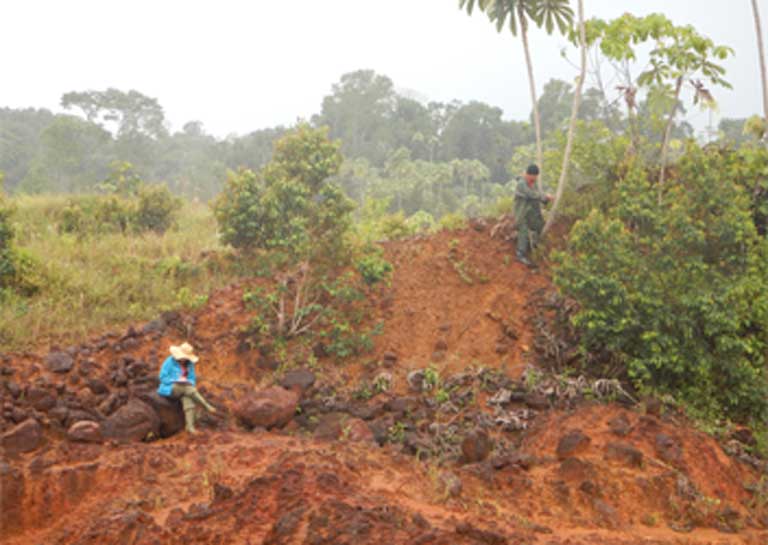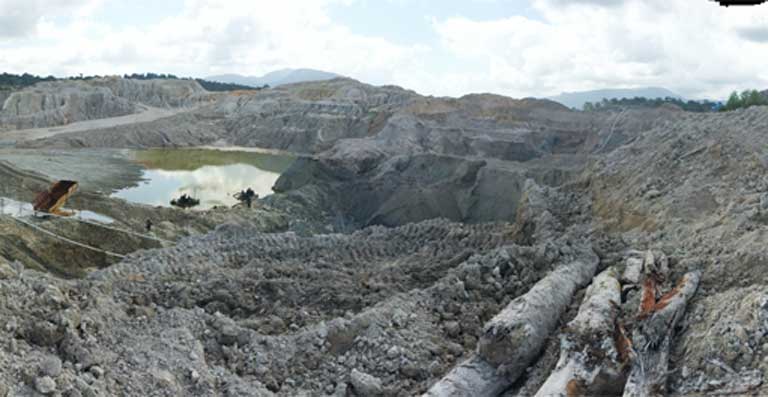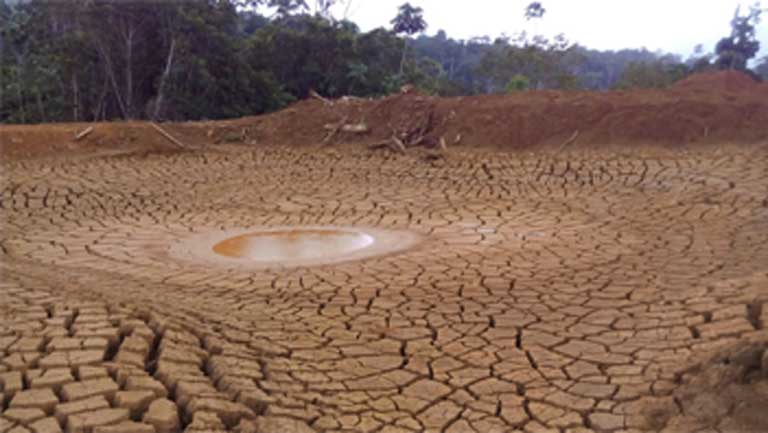- New research looking at Amazon artisanal gold mining in Guyana has found that the destroyed Amazon forest at mining sites shows no sign of recovery three to four years after a mine pit and tailings pond are abandoned, likely largely due to soil nutrient depletion.
- In addition, mercury contamination at the sites drops after a mine is abandoned; mercury is used to process gold. Mercury being a chemical element, it does not break down but can bioaccumulate, so its onsite disappearance means the toxin is possibly leaching into local waters, entering fish, and poisoning riverine people who eat them.
- The solution would be the proper restoration of mine sites, especially the proper filling in of mine holes and tailing ponds imitating replacement by natural topsoil. Better regulations, much bigger fines and other penalties, along with enforcement of mining laws would also help seriously curb the problem, say researchers.
- But so long as the price of gold continues topping $1,700 an ounce (as it did during the 2008 U.S. housing crisis), or $2,000 an ounce (its current price during the still escalating COVID-19 pandemic), it seems likely that there is little that can curb the enthusiasm of poor and wealthy prospectors alike for digging up the Amazon.

The remote Guiana Shield of the Northern Amazon holds some of the largest tracts of unfragmented forest on the planet, but the rapid growth of gold mining in the region threatens to leave a patchwork of devastation for many years to come, a new study has found.
The research, published in the Journal of Applied Ecology, found that forest recovery at abandoned Amazon artisanal goldmines remains barren, with virtually no tree growth, three to four years after the miners packed up their equipment and left for othe\r Amazon prospects.
The Guiana Shield covers 270 million hectares (over 1 million square miles), encompassing Guyana, Suriname, French Guiana, parts of Venezuela, Colombia and northern Brazil. The region offers spectacular ecological services: it stores 18% of the world’s tropical forest carbon and 20% of the world’s fresh water. It also sits atop a massive, widespread gold deposit that has sparked the interest of local and international profit-seekers.
The paper’s lead author Dr. Michelle Kalamandeen, a former postgraduate researcher at the School of Geography at Leeds, and a current postdoctoral researcher at Cambridge University, has studied small-scale mining in the Amazon for several years. She explained that while previous studies have looked at forest recovery from agricultural activities, there has not been a field-based assessment of forest recovery from artisanal gold mining. The new study was based on field research at 18 plots spread across two well-known gold mining areas — Mahdia and Puruni — in central Guyana.
“There was very little recovery three to four years after a mine pit and tailings pond had been abandoned,” Kalamandeen said. “The overburden site where the discarded topsoil was piled up had a similar rate of recovery to agriculture plots in South and Central America.”
Dr. David Galbraith, who is an associate professor at the School of Geography, University of Leeds, co-designed the study with Kalamandeen as part of her PhD work. Galbraith pointed toward depleted nutrients as a primary reason that the forest failed to recover.
“Our study finds that the stripping of nutrients during the excavation process may be particularly important in restricting recovery. Other modes of deforestation are not associated with the stripping of topsoil in this way,” Galbraith said.

The study suggested specifically that depleted nitrogen levels were responsible for the restricted growth, as opposed to contamination from heavy metals such as mercury. The research, which sampled for mercury contamination, found levels dropped 250 times lower in abandoned sites compared to active mining areas. Rather than this being a positive finding, Kalamandeen suggested that the toxic element — which doesn’t break down — was likely leaching out into the wider ecosystem, causing problems particularly for nearby indigenous communities who depend on fish as a primary source of food. The study did not explore that possibility within its scope.
Although agriculture and extensive cattle ranching are responsible for far more total deforestation in Amazonia, the rainforest’s ability to sequester carbon is much more severely impacted from gold mining on a per hectare basis. According to Kalamandeen. Large portions of the rainforest are under mining concessions, and there have been an estimated 1,680 square kilometers (617 square miles) of the Amazon lost to gold mining between 2001 and 2013, according to a 2015 study.
“We estimate that the slow recovery rates in mining pits and ponds currently reduce carbon sequestration across Amazonian secondary forests by [around] 21,000 [tons of carbon per year], compared to the carbon that would have accumulated following more traditional land uses such as agriculture or pasture,” the study authors wrote, referencing lands already lost to gold mining.
Juliana Siqueira-Gay, a researcher on tropical mining who was not involved in the study, reviewed the new research favorably, saying it haS important implications for creating new policies for the rehabilitation of post-mining sites.
“The findings support requirements for large scale restoration of mining areas. This is a contribution not only for science but also to support land management and rehabilitation plans in mining areas,” Siqueira-Gay said.
Kalamandeen suggested that the new research could help guide effective landscape restoration. It is particularly important, she said, that mining pits and tailing ponds be refilled with topsoil in a way that mimics natural soil layers. The problem, of course, is the cost of such restoration, which she noted can run up to $3,000 per hectare in some cases, which is often much more expensive than paying fines for violating environmental regulations — especially considering that environmental fines when assessed in nations like Brazil are rarely if ever paid.
In addition to the immediate environmental devastation at gold mining sites, a 2017 study found that the infrastructure built to support large-scale industrial Amazon mining operations causes increased deforestation to ripple far into surrounding forests.
The researchers in that study published in the journal Nature Communications used satellite imagery to show that 11,670 square kilometers (roughly 4,500 square miles) of the Amazon, the world’s largest rainforest, were lost due to mining between 2005 and 2015, accounting for nearly 10 percent of Amazon deforestation. That loss extended by as much as 70 kilometers (approximately 43 miles) due to ancillary infrastructure, including roads, staff housing, and airports.

Gold mining bonanza
In Guyana, locals have been extracting gold from rivers using artisanal methods since before colonization. The practice, however, has expanded rapidly in the country over the past 10 to 15 years as the price of gold has risen, and as mechanized techniques have delivered greater opportunities for profit.
Kalamandeen explained that the majority of Guyana mines are built as small-scale operations, whose production levels fluctuate based upon changing economic conditions and opportunities. Many miners work as loggers when the price of gold drops, but will shift to gold mining when prices rise, jumps which are often linked to societal upheavals such as economic crashes.
In 2008, the U.S. housing crisis led to the price of gold jumping to US$1,700 per ounce. At the time, small-scale mining operations exploded across Guyana, but later subsided, as did mining-related deforestation, when international gold prices declined. Since COVID-19 arrived, massively impacting the world economy over the course of the first half of 2020, the price of gold has soared to over US $2,000 per ounce and is projected to go even higher.

Kalamandeen said that there are already reports on the ground that gold mining in the Amazon is increasing as the global pandemic and economic crisis worsens, and that a lack of monitoring, enforcement and the weakening of environmental laws will almost certainly further exacerbate the situation.
“We’re already seeing reports of increased mining activity. Based on the reports, it looks like it’s almost turning into something of a [gold mining] free-for-all,” Kalamandeen said.
While Guyana law requires mining companies to restore the forest ecosystem, the majority of miners fail to follow regulations, opting to pay a small fine, which can be much less costly than restoring the land, according to Kalamandeen.
“The fines are too low, and there is not enough monitoring or enforcement to make sure the land is restored. Until the costs of not restoring the land reflects the price of restoration, the same problems will occur in the future,” Kalamandeen concluded.
Citation:
Kalamandeen, M., Gloor, E., Johnson, I., Agard, S., Katow, M., Vanbrooke, A., Ashley, D., Batterman, S. A., Ziv, G., Holder‐Collins, K., Phillips, O. L., Brondizio, E. S., Vieira, I., Galbraith, D. Limited biomass recovery from gold mining in Amazonian forests. Journal of Applied Ecology, 2020.
Banner Image: Tailing pond at gold mining site in Mahdia, Guyana. Image by Michelle Kalamandeen 2017.
.
